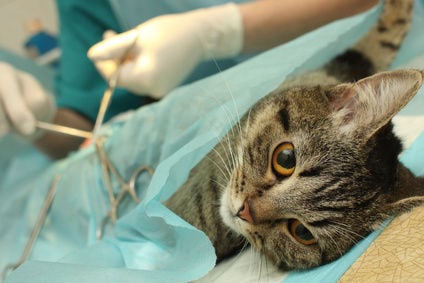Spaying or neutering your cat seems a very responsible step for pet owners to take. Many a pet owner we see in our veterinary clinic are increasingly viewing this surgery as an obvious thing to do. That’s a good trend to see.
But have you ever wondered what the difference between spay and neuter implications are for your cat? In this article, you’ll learn the positive implications of spaying or neutering cats but also the negatives as well.

Table of Contents
Why is it important to spay and neuter your pet?
The more important benefit of spaying and neutering is to control the cat population. This is especially true when we look at the part of the population that consists of unwanted cats in shelters and on streets. As loving cat owners, it’s heartbreaking to see.
If you don’t want to add to those numbers, spaying or neutering your cat is the way to go. Also, many owners of a female cat can eliminate the task of finding homes for countless litters of kittens just by spaying their pet cat. Even if those owners do find good homes for all of the kittens, these litters still add to the overall population and reduce the chances of finding homes for shelter cats.
The pet overpopulation problem is also the responsibility of owners of male cats as well. Male cats don’t get pregnant and many pet owners don’t know if their unneutered male cat is siring litters. But they can be. If there are females in heat, a male cat can sire a litter as frequently as every day. Many are surprised to learn that most male cats who go outside do.

On the other hand, if you are planning to breed your cat at some point, spaying or neutering is something that conflicts with those plans. It’s obvious right? Spaying and neutering surgeries are irreversible. That is, they cannot be reversed if you decide to breed your cat later.
Will your cat’s personality change after the spay or neuter?
Spaying and neutering alter the behavior of cats enormously. The effects are most apparent in male cats. However, females change their behavior as well.
In male cats, most of their sexual behavior is initiated by testosterone which is produced by their testes. Since neuter surgery is a procedure that consists of the removal of the testes, testosterone is no longer produced. Therefore, unwanted behavior that were a problem fade out naturally. Those include:
- Urine marking
- Wandering around or constantly trying to escape the house or yard
- Inter-cat aggression and fighting
Female cat owners have a less troublesome life, but they have their own worries in the form of the heat cycle. When a female cat is spayed, she will no longer come into heat. Thankfully the following symptoms will no longer bother you:
- Excessive vocalization
- Aggression
- Crawling, rolling, and acting crazy
You may read a more complete list of female cat heat symptoms here. They will all will go away after your cat is spayed, as will the worry of your cat getting pregnant. Many owners of female cats choose to overcome this issue by using medicine to prevent their cat from going into heat. Studies however, show this type of medicine increases the risk of reproductive system disorders, including uterine cancers. We veterinarians deal with issues of this nature quite often unfortunately.
Studies also show that both genders become less active, more friendly, more playful, and they tolerate handling better. In addition, neutered males are reported to seek more attention compared to intact ones.
You can find out more about behavior changes in cats after spaying and neutering here.
Note: if you spay or neuter an older cat, some of the behaviors listed above may not change without some additional training and environmental modifications. Or, these behaviors may disappear gradually over several months. However, castration through neuter surgery is still the most significant tool in changing unwanted behavior in male cats.
What are the health effects of spaying or neutering a cat?
Besides altering your cat’s behavior, spaying and neutering affects your cat’s health as well.
First, both procedures are surgery. As with any surgery, it carries some risk of complications both during the surgery itself and during the postoperative period.

Spaying a female cat is more complex than neutering a male cat. Thus, the associated risks are higher for female cats. Further, the recovery period is longer for them.
On the other side of the coin, spaying and neutering eliminates the risks of developing ovarian and uterine tumors in female cats and testicular cancers in male cats. Because those reproductive organs are removed, there is no possibility of developing related diseases.
Spaying or neutering a cat reduces the risks of mammary cancer in females and prostatic cancer in males. The risk is reduced even further in female cats if the cat is spayed before one year of age. In male cats, neutering also reduces wandering and fighting with other cats as mentioned above. This in turn minimizes the spread of infectious and invasive diseases, fleas, and injuries caused by fighting.
One benefit that is not often mentioned is that spay and neuter surgery can lead to a longer lifespan for your cat.
A study conducted by Banfield Pet Hospitals on a database of 460,000 cats concluding that spayed female cats in the study lived 39% longer and neutered male cats lived 62% longer.
Human Society
Spaying and neutering, however, may increase the risk of developing urinary incontinence. This risk is extremely low-much lower than in dogs-but it does exist. In addition, neutered male cats are at greater risk of developing diabetes.
To sum up, we think you should spay or neuter your cat if you are not planning to breed her or him. In our opinion, that’s one of the main reasons for or against doing so. All of the other cited advantages, included improved behavior, possible longer lifespan, and reduced or eliminated risk of certain diseases, are side benefits in favor of spaying and neutering cats. So the difference between spay and neuter positives and negatives definitely favoring the spaying and neutering path.
By spaying and neutering your cat, both you and your cat will have to deal with the surgery postoperative care, but this is a short period. The benefits that follow are worth it based on the feedback we hear from our pet owners in our veterinary clinic. This will go a long way towards a happy life for you and your cat. And keeping your Pet Happy is what we all want.
